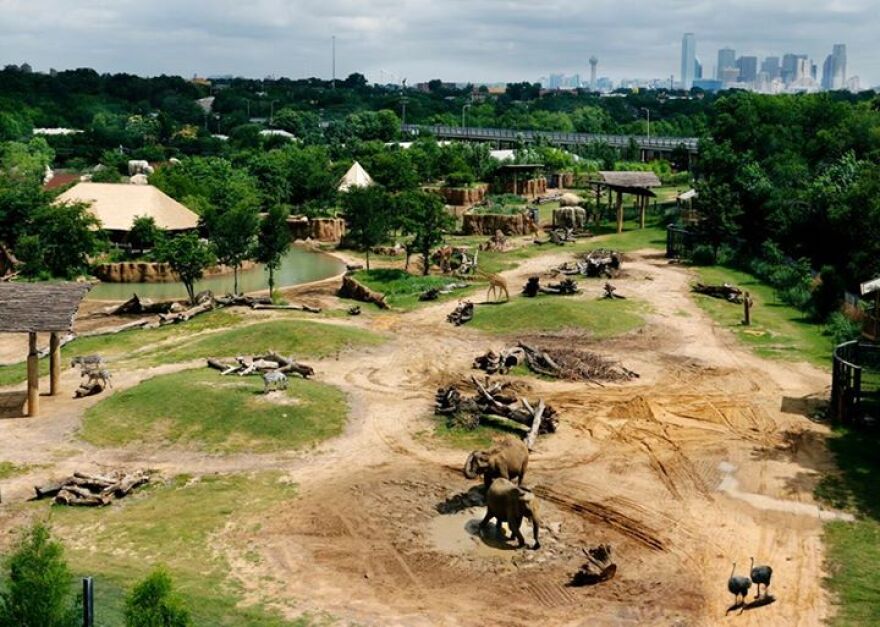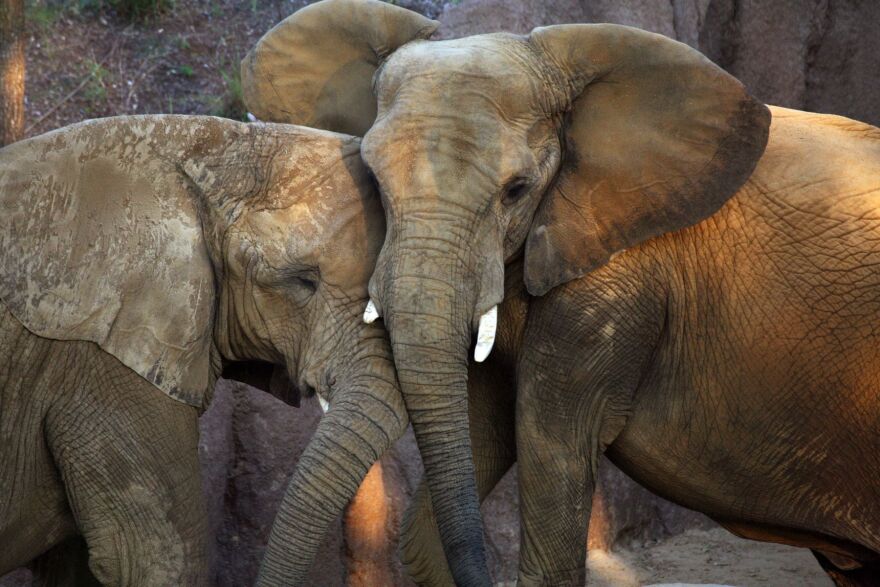The Dallas Zoo is among three American zoos looking to import 18 elephants that are in danger in Swaziland, a country in southern Africa. As they wait for approval from the federal government, animal rights activists are speaking out against the move.
There are already four elephants at the Dallas Zoo: Jenny, Gypsy, Kamba and Congo. The zoo calls them the “Golden Girls,” four geriatric elephants roaming six acres of a manmade African Savanna, complete with varying sceneries of tall trees, grass, sand and water.
At the zoo, President and CEO Gregg Hudson pointed to a net of hay suspended from a tower at the far end of the elephant habitat.
“That’s a hay net,” he said. “In the old days, we would take hay and just dump it on the ground, but the way elephants browse in the wild, they’re taking branches and pulling down.”
A Natural Habitat For Elephants
The current elephant habitat here, Giants of the Savanna, opened in 2010 and was the first in the country and the second in the world to mimic the wild by mingling elephants with hoofed animals like zebras and giraffes.
It was designed by elephant experts to care for the individual needs of both older and younger animals, and it includes pathways for elephants to walk more than 10 miles a day.
Hudson said the zoo’s done extensive research over the years to provide their Golden Girls as natural an environment as possible.

Bringing Elephants To North Texas
“In 2006, when I first got here, our elephant habitat was not a good habitat,” Hudson said. “And so we made the decision that we were going to either get out of exhibiting elephants or show the world how a zoo can do that.”
The Dallas Zoo, along with the Henry Doorly Zoo in Omaha and the Sedgwick County Zoo in Wichita, Kansas, are waiting for permits from U.S. Fish and Wildlife to import the 18 elephants, as part of a project overseen by a group called Room For Rhinos.
The elephants have been removed from two privately managed parks in Swaziland. Officials there say the elephants are overcrowding and depleting resources needed by endangered black and white rhinos. With worsening drought conditions and aggressive poaching in nearby countries, they say Africa has become unsafe for elephants, and these animals either need to be moved to a zoo or sanctuary or be culled.
Hudson said that’s why they jumped at the opportunity to house them. The year-long application process has been an intensive process for the Dallas Zoo.
“It’s got a lot of science into it, a lot of forethought of what these animals are going to do on a day-in-day-out basis. And so hopefully, we are a viable option for these animals that need a place to come to,” he said.
Elephants Should Be In The Wild, Advocates Say
A global community of scientists, conservationists and welfare experts are trying to block the import and keep the elephants in the wild, where they say they belong.
“Legitimate conservation is about ensuring that these animals will exist and be able to be in the wild for generations to come. It’s not about warehousing and captive breeding programs,” said Carney Anne Nasser, a lawyer with the Animal Legal Defense Fund. “Offering $450,000 for 18 elephants to divvy them up among different zoos has nothing to do with conservation and everything to do with boosting ticket sales.”
Nasser and activists say it’s widely known that elephants don’t thrive in zoos. Separation from family members, limited movement and lack of stimulation are all actors that can lead to a variety of mental and physical ailments. Scientists have documented that elephants in captivity can develop aberrant behaviors and reproductive issues.

And while elephants in the wild generally live to be 50 to 60 years old, experts say elephants in zoos generally don’t live that long. A Seattle Times investigation in 2012 found that of the 321 elephant deaths it studied at accredited American zoos, half of them were at age 23.
“In fact, even though elephants in captivity receive daily care,veterinary treatment when needed and consistent nutrition, they’re not living as long as elephants in the wild because in captivity. They’re developing problems that are actually aging and killing them before their time,” said Catherine Doyle, the director of science, research and advocacy at the Performing Animal Welfare Society.
The Golden Girls at the Dallas Zoo are all in their 30s, and Dallas’ oldest elephant, Mama, was 45 when she died last May. The oldest African elephant in the U.S. died recently in Utah at 55-and-a-half.
Doyle said it’s about quality of life, and rather than spending millions of dollars on state-of-the-art habitats, zoos should invest in conservation efforts that can allow elephants to stay wild. The Henry Doorly Zoo, for example, has invested about $70 million in a new outdoor grassland habitat, and the Dallas Zoo has built an 11,000-square-foot holding warehouse for their elephants.

“The question shouldn’t be whether we can improve the fundamental aspects of elephants in zoos, but can we provide lives that allow elephants to become who they really are, these self-aware animals who are rich in intellect and who experience a range of emotions including empathy and mourning their dead,” Doyle says. “Captivity will never meet elephants' complex needs or help them in any way.”
Dallas Zoo officials say that mentality is rooted in the way zoos used to be years ago, and that a lot has changed in how they care for animals overall.
The zoo hopes to know soon if it’ll be able to welcome six new elephants to their Giants of the Savanna habitat. If the permits are approved, the elephants could be flown to North Texas in early 2016.






